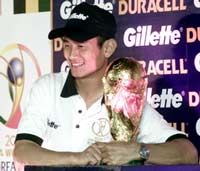World Cup glory a distant dream for India
N Ananthanarayanan
Thousands of fans in the soccer-mad city of Calcutta lived a World Cup dream for a few hours recently, though they knew it might never come true.
Cheering and jostling, they packed a large stadium to watch top Indian striker Baichung Bhutia carry the FIFA World Cup trophy atop a decorated elephant.
But the victory procession was make-believe; a clever sales pitch by a World Cup sponsor putting soccer's ultimate prize on display in key Indian cities ahead of the competition itself, which kicks off in Japan and South Korea on May 31.
 Indian national soccer team captain Baichung Bhutia holds a replica of the FIFA World Cup in Calcutta.
Indian national soccer team captain Baichung Bhutia holds a replica of the FIFA World Cup in Calcutta.
|
Asia's first soccer World Cup has whipped up a frenzy across India and revived echoes of past glory around the country which set the ball rolling in the region more than half a century ago.
India were the first Asian Games soccer champions in 1951 and won again in 1962. In a country where soccer roots run deep, millions of cricket fans will shift their traditional loyalties during May and June.
Sales of colour television sets are soaring and many companies hope to cash in on soccer madness in the world's second most populous country which is home to more than a billion people.
But the real business of Indian soccer itself is deep in the doldrums with its skilful players who held their own in an era of barefoot play and bubbling amateur spirit fading into distant memory.
After more than two decades of poor performances, India's world ranking in football stands at a lowly 123, and in Asia at 23.
GAME LANGUISHES
Bumpy pitches, a lack of fresh talent without meaningful youth schemes and a national league which has limped along for six years with sponsorship problems have taken their toll.
Indian clubs dish out ordinary fare before thin crowds with hardly any live television coverage. Most channels instead fight fiercely for the lucrative cricket market in a country where cricket stars are national heroes.
"In my time it was amateur football. It was all passion," Pradip Kumar Banerjee, India's best-known player and a top winger in the 1950s and 1960s, told Reuters.
The former national coach says any hopes of revival lie in clubs turning professional and giving local talent a chance instead of mediocre foreign players that the All India Football Federation (AIFF) has allowed clubs to bring in.
"We are getting third-class Africans," said Banerjee. The AIFF, under pressure from clubs, has decided to reduce the number of foreigners per club from four to two from next season.
AIFF secretary Albert Colaco admitted much more needed to be done to lift Indian soccer.
"Things need a radical change. Ideally professionals should be running the association and clubs," he told Reuters.
Honorary officials run India's politics-riven sports bodies which face constant allegations of financial mismanagement.
POOR ADMINISTRATION
A top Asian soccer official criticised two poorly-maintained soccer grounds in New Delhi as unfit for international games after an inspection tour two years ago.
The AIFF faced acute embarrassment last year when an international tournament it organised was dismissed as a farce after late withdrawals and crowd apathy.
But despite the troubles, the game remains hugely popular.
Newspapers are running special sections in the run-up to the World Cup and business is booming.
"We are expecting 100 percent increase in (television) sales in soccer-crazy states like West Bengal, Kerala, Goa and the northeast states," Rajeev Karwal, a senior executive at electronics giant Philips told Reuters. "The industry should benefit by 25-30 percent in April-June over last year."
Some five-star hotels plan food discounts of up to 30 per cent to draw fans in to watch the games on big screens.
But as Indians prepare to watch from the sidelines, many are also looking back on the long history of soccer in their country and wondering about lost opportunity.
India still stages the 114-year-old Durand Cup, the world's oldest tournament after the English FA Cup, and which triggered patriotic fervour at the height of the freedom movement when Mohammadan Sporting upset a British side to become the first victorious Indian club in 1940.
A year after independence in 1947, the barefoot Indians caused a sensation against France at the 1948 London Olympics, taking an early lead before missing a penalty to lose 2-1.
India turned down a late invitation to the 1950 World Cup in Brazil only because its players were not used to playing in shoes.
There followed a 4-2 victory over Australia in the 1956 Melbourne Olympics, a 1-1 draw against France in Rome four years later and an Asian Games bronze in 1970 before the rot set in.